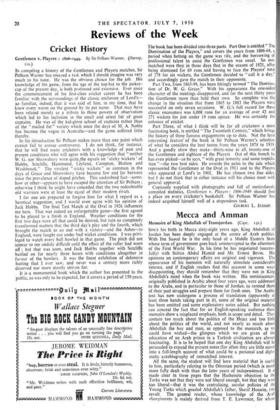Reviews of the Week
Cricket History
IN compiling a history of the Gentlemen and Players matches, Sir Pelham Warner has essayed a task which I should imagine was very much to his taste. He was the obvious choice for the job. His knowledge of the game, from the age of the top-hat to the jockey- cap of the present day, is both profound and extensive. Ever since the commencement of his first-class cricket career he has been familiar with the surroundings of the classic enclosure of Lord's— so familiar, indeed, that it was said of him, in my time, that he knew every worm on the ground by its pet name. That may have been related merely as a tribute to those powers of observation which led to his inclusion in the small and select list of great captains. He was of the kid-glove school of captains rather than of the " mailed fists" variety which since the days of M. A. Noble has become the vogue in Australia—and the game suffered little thereby.
In. his introduction Sir Pelham makes more than one point which cannot fail to arouse controversy. I do not think, for instance, that he will find many cricketers with a knowledge of past and present conditions who will agree with his suggestion that " neither W. G. nor Shrewsbury were guitejhe equals on ` sticky wickets ' of Hobbs, Sutcliffe, Hammond, Leyland, Compton, Hutton and Washbrook." The virulent " sticky wickets " so common in the days of Grace and Shrewsbury have become few and far between since the prevalence of doped pitches. This undoubted fact—some- how or other—appears to have escaped the attention of Sir Pelham ; otherwise I think he might have conceded that the two redoubtable old warriors were at least the equal of their modern rivals.
I for one am prepared to forgive him for what I regard as a heretical suggestion, and I would even agree with his opinion of Jack Hobbs. The final Test Match at the Oval in 1926 influences me here. That was indeed an unforgettable game—the first agreed to be played to a finish in England. Weather conditions for the first two days were all that could be desired, but rain so completely transformed matters that the third day's play and the fourth, which brought the match to an end with a victory—and the Ashes—to England, were fought out under bad wicket conditions. I was privi- leged to watch every ball bowled in that game. The pitch did not appear to me unduly difficult until the effect of the roller had worn off : but that was soon, and Jack Hobbs together with Sutcliffe battled on for nearly three hours with conditions altogether in favour of the bowlers. It was the finest exhibition of defensive batting that I ever saw, and never was a century more richly deserved nor more stoutly striven for.
It is a monumental book which the author has presented to the 'public, as was only to be expected, for it covers a period of 150 years. The book has been divided into three parts. Part One is entitled " The Domination of the Players," and covers the years from 1806-64, a Period when betting on the game was rife, and the borrowing of professional talent to assist the Gentlemen was usual. So out- matched were they.in those days that in the season of 1821, after being dismissed for 69 runs and having to face the Players' total of 278 for six wickets, the Gentlemen decided to " call it a day," and accordingly gave the match to their opponents. Part Two, from 1865-99, has been fittingly termed "The Domina- tion of Dr. W. G. Grace." With his appearance the one-sided character of the meetings disappeared, and for the next thirty years the Gentlemen more than held their own. So complete was the change in the situation that from 1865 to 1883 the Players were successful on only seven occasions. W. G.'s full record for these classic encounters was 6,008 runs for an average of over 42 and 271 wickets for just under 19 runs apiece. He was certainly the colossus of cricket.
Part Three, of what I think will be for all cricketers a most fascinating book, is entitled " The Twentieth Century," which brings the history of these famous engagements up to date. Not the least interesting feature' of the book is Sir Pelham Warner's selection of what he considers the best teams from the years 1878 to 1939. And a goodly show they make—thirty-nine in all, twenty-one of the Gentlemen and eighteen of the Players. Out of this bunch he has even picked—as he says, " with great temerity and some trepida- tion "—the two best sides. He awards the palm to the side which represented the Gentlemen at the Oval in 1911 and to the Players who appeared at Lord's in 1901. He has chosen two fine sides, but I do not think that in either instance will his choice meet with general approval.
Copiously supplied with photographs and full of meticulously compiled statistics, Gentlemen v. Players : 1806-1949 should find a place on every tricketer's bookshelf. Sir Pelham Warner- has indeed acquitted hhnself well of a stupendous task.
GILBERT L. JESSOP.






































 Previous page
Previous page